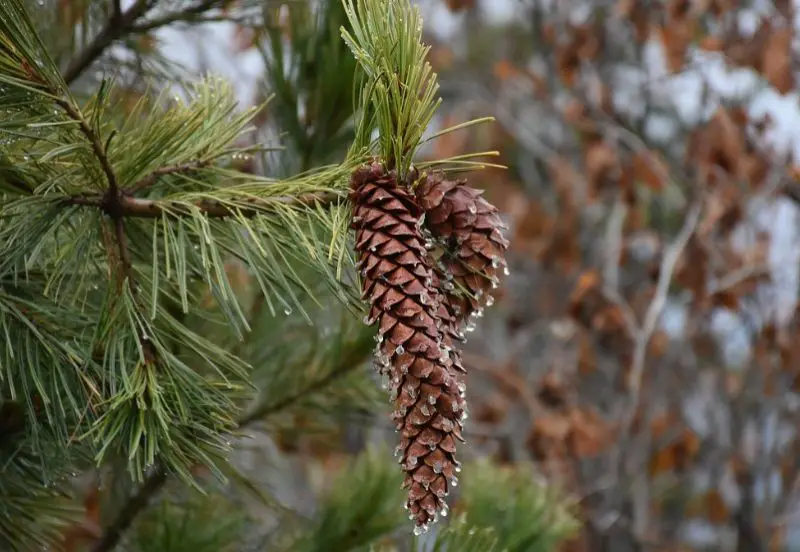Western White Pine (Pinus monticola), also known as mountain white pine, is a majestic evergreen tree native to the western regions of North America. Renowned for its tall stature, soft needles, and graceful appearance, this tree is a favorite among gardeners and landscapers alike.
In this comprehensive care and growing guide, we will explore everything you need to know about cultivating and maintaining a healthy Western White Pine in your garden.
What is Western White Pine?

Overview of Western White Pine
Western White Pine is a majestic coniferous tree belonging to the Pinaceae family, renowned for its graceful appearance and adaptability to various landscapes. Its scientific name, Pinus monticola, reflects its mountainous origins, as this species is native to the western regions of North America, ranging from British Columbia down to California. Commonly referred to as Mountain White Pine or Silver Pine, this tree thrives in the cooler climates of high-altitude forests.
Botanical Characteristics
Scientific Classification and Common Names
The scientific name of Western White Pine is Pinus monticola, and it is commonly known by several names, including Mountain White Pine and Silver Pine. These names reflect its natural habitat in mountainous regions and its characteristic silvery-blue foliage.
Size and Growth Habit
One of the most striking features of Western White Pine is its tall, conical shape, complemented by slender, flexible branches that create a soft, feathery silhouette. In optimal conditions within its native habitat, it can reach impressive heights of up to 150 feet, towering over other forest species. However, when cultivated in gardens or urban landscapes, it typically grows to a more manageable size of 50 to 80 feet, maintaining its elegant form while fitting well into large outdoor spaces.
Needle and Cone Description
The foliage of Western White Pine is easily recognizable by its bluish-green needles, which grow in bundles of five. These needles are soft to the touch, giving the tree a delicate, almost fluffy appearance that sways gracefully in the wind. This unique coloration provides a beautiful contrast against darker green conifers, enhancing its ornamental value.
The tree produces long, cylindrical cones that range from 5 to 12 inches in length. When mature, these cones take on a light brown hue and hang elegantly from the branches. They release small, winged seeds that play an essential role in the tree’s reproductive cycle and also provide food for various wildlife species, including birds and small mammals.
Ideal Uses in Landscaping
Windbreaks and Privacy Screens
Western White Pine’s tall and dense growth habit makes it an ideal choice for windbreaks and privacy screens. Its thick foliage provides effective shielding from harsh winds and helps create secluded outdoor spaces.
Ornamental Specimen Trees
Thanks to its graceful conical shape and elegant needle clusters, Western White Pine serves as a striking ornamental specimen tree. It stands out beautifully in expansive gardens or parks, adding vertical interest and a sense of grandeur.
Woodland Gardens and Natural Landscaping
In more naturalistic settings, Western White Pine fits seamlessly into woodland gardens, contributing to a layered, forest-like environment. Its soft, bluish-green needles blend harmoniously with other native plants, enhancing the overall aesthetic of naturalized landscapes.
Reforestation and Habitat Restoration
Beyond its decorative appeal, Western White Pine is valuable in ecological projects such as reforestation and habitat restoration. Its rapid growth and adaptability to diverse soil types make it an excellent candidate for stabilizing slopes and rebuilding forest ecosystems. Moreover, its ability to support local wildlife enhances biodiversity and promotes a balanced, thriving habitat.
Growing Conditions for Western White Pine
Western White Pine is a resilient and adaptable tree that thrives in specific environmental conditions similar to its native mountainous habitats. To ensure healthy growth and longevity, it is essential to provide the right climate, sunlight, soil, and protection from harsh weather elements.
Climate Requirements
Western White Pine flourishes in cool, moist climates and is well-suited for USDA hardiness zones 4 to 7. In these zones, temperatures typically range from -30°F to 90°F. The tree performs best in regions with mild summers and cold winters, mimicking the climate of its native environments in western North America.
This species is particularly well-adapted to high-altitude areas with cooler temperatures and consistent moisture levels. It prefers environments where summers are not excessively hot, as extreme heat can stress the tree and affect its growth rate. Additionally, cold winters are beneficial, promoting dormancy and preparing the tree for vigorous growth in the spring.
Western White Pine can tolerate light frost and snow, but it is sensitive to prolonged exposure to extreme cold or rapid temperature fluctuations. In regions with harsh winter winds, it is advisable to plant the tree in a somewhat sheltered location to minimize potential damage.
Sunlight Needs
Western White Pine grows best when exposed to full sun to partial shade. Ideally, it should receive at least six hours of direct sunlight each day to maintain a healthy growth rate and vibrant, bluish-green foliage. Full sun exposure promotes robust branching and dense needle clusters, enhancing the tree’s ornamental appeal.
While the tree can tolerate some shade, prolonged periods without sufficient sunlight may result in sparse foliage, reduced growth, and a less vigorous overall appearance. Partial shade is acceptable, particularly during the hottest part of the day, as it can protect the tree from excessive heat and moisture loss.
In densely wooded areas, young Western White Pine trees may struggle to compete for sunlight with larger, more established trees. Ensuring adequate space between trees or selectively thinning surrounding vegetation can help provide the necessary light for optimal growth.
Soil Preferences
Type and Drainage
Western White Pine prefers well-drained soil that prevents waterlogging, as overly saturated soil can lead to root rot and other fungal diseases. Sandy or loamy soils are ideal because they provide the necessary drainage while retaining enough moisture to support the tree’s growth.
Although it can tolerate rocky or slightly clayey soils, proper drainage is essential. In areas with heavy clay soil, amending the planting site with organic matter, such as compost or peat moss, can improve drainage and soil structure. Raised planting beds are another option for enhancing drainage in challenging soil conditions.
pH Range
Western White Pine thrives in slightly acidic to neutral soil, with an optimal pH range of 5.0 to 7.0. Acidic soils closely resemble the natural forest floors of its native habitats, rich in decomposing organic matter from pine needles and other vegetation.
If soil tests indicate a pH outside this range, amendments such as sulfur or aluminum sulfate can help lower the pH, while lime can be added to raise it. Regular soil testing ensures that the pH remains within the ideal range, promoting nutrient availability and overall tree health.
Moisture Requirements
Consistent soil moisture is crucial for Western White Pine, particularly during its early years of establishment. The soil should be kept moist but not waterlogged, as excessive moisture can damage the roots. A layer of mulch around the base of the tree helps retain soil moisture and regulate temperature, reducing the need for frequent watering.
During prolonged dry spells, supplemental watering may be necessary, especially in sandy soils that drain quickly. Deep watering encourages strong root development, enhancing the tree’s resilience to drought and wind stress.
Wind and Snow Tolerance
Western White Pine exhibits moderate resistance to wind, thanks to its flexible branches and conical shape, which allow it to sway rather than snap under pressure. However, young trees are more vulnerable to strong winds and may require staking for support until their root systems are fully established.
While the tree can withstand light snow and frost, heavy snow or ice accumulation on its branches can cause breakage or deformity. Planting in a location protected from harsh winter winds, such as near a windbreak or on the leeward side of a slope, can minimize the risk of damage.
In areas prone to heavy snowfall, regular monitoring and gentle removal of snow buildup on branches can prevent breakage. Additionally, pruning to remove weak or damaged branches reduces the likelihood of snow-related damage and maintains the tree’s structural integrity.
How to Plant Western White Pine
Planting Western White Pine requires careful planning and proper technique to ensure healthy growth and long-term vitality. From selecting the ideal location to following the correct planting steps, attention to detail is essential to give this majestic tree the best start in your landscape.
Choosing the Right Location
Selecting the right location is crucial for the successful growth of Western White Pine. This tree can reach heights of 50 to 80 feet when cultivated in gardens and even up to 150 feet in its native habitat. It also has a spread of 20 to 30 feet at maturity, so ample space is necessary to accommodate its full size without interference.
It is important to avoid planting too close to buildings, power lines, or other structures to prevent potential hazards as the tree grows. Additionally, the root system of Western White Pine expands widely to support its tall stature, so ensure the site is free of underground utilities or hardscaping elements that could obstruct root development.
Western White Pine thrives in locations that receive full sun to partial shade, with at least six hours of direct sunlight daily. Sufficient sunlight is vital for maintaining healthy needle clusters and promoting vigorous growth. In partially shaded areas, the tree may become sparse or grow unevenly, diminishing its ornamental appeal.
The chosen site should also have well-drained soil to prevent waterlogging, which can cause root rot and other fungal diseases. Elevated or sloped areas are excellent choices as they naturally facilitate drainage. If planting on flat terrain or in clay-heavy soils, consider amending the soil with organic matter or creating raised planting beds to improve drainage.
In areas prone to strong winds or heavy snowfall, planting in a sheltered location, such as near a windbreak or on the leeward side of a hill, can help protect the tree from harsh weather conditions. This is particularly important for young trees that are more susceptible to wind stress and snow damage.
Planting Steps
Proper planting techniques ensure that Western White Pine establishes strong roots and grows healthily. Follow these detailed steps to plant the tree successfully:
Digging the Hole
Start by digging a hole that is twice as wide and as deep as the tree’s root ball. The extra width allows the roots to spread out more easily, promoting better stability and nutrient absorption. The depth should match the height of the root ball to ensure the tree is planted at the same level it was growing in the container.
Avoid digging too deep, as planting the tree too low can lead to poor drainage and root suffocation. Conversely, planting too high can expose the roots, leading to dehydration and instability.
Preparing the Root Ball
Carefully remove the tree from its container, being gentle to avoid damaging the roots. If the root ball is tightly packed or circling inside the container, gently loosen the roots with your hands or a small garden tool. This encourages the roots to grow outward into the surrounding soil instead of continuing to spiral, which can eventually strangle the tree.
For trees wrapped in burlap, remove any string or wire securing the burlap, and peel back the burlap from the top one-third of the root ball. If the burlap is synthetic, remove it entirely, as it will not decompose and can hinder root growth.
Planting the Tree
Place the tree in the center of the hole, ensuring it is upright and straight. Position the tree so that the root flare—the area where the trunk transitions to the roots—is at or slightly above ground level. This prevents soil from accumulating around the trunk, which can cause rot and disease.
Begin backfilling the hole with the excavated soil, gently packing it around the root ball to eliminate air pockets. It is important to avoid compacting the soil too tightly, as this can hinder root penetration and water absorption.
Once the hole is half-filled, water the soil to help it settle around the roots. Continue backfilling and finish with a final watering to ensure the tree is securely anchored.
Watering
After planting, water the tree thoroughly to help the soil settle and eliminate remaining air pockets. Deep watering is essential to encourage the roots to grow downward, promoting stability and drought resistance.
During the first growing season, keep the soil consistently moist but not waterlogged. Watering once a week is generally sufficient, but frequency may vary depending on climate and soil type. In sandy soils, more frequent watering may be necessary, while in loamy soils, less frequent watering is adequate.
Mulching
Apply a 2 to 3-inch layer of mulch around the base of the tree, extending out to the drip line. Mulching helps retain soil moisture, regulate soil temperature, and suppress weed growth, reducing competition for nutrients.
However, it is crucial to keep the mulch from touching the trunk to prevent moisture buildup, which can lead to bark decay and pest infestations. Leave a gap of about 2 inches between the trunk and the mulch layer for proper air circulation.
Organic mulch materials, such as pine needles, wood chips, or shredded bark, are ideal choices as they gradually decompose and enrich the soil. Refresh the mulch layer annually to maintain its effectiveness and aesthetic appeal.
Planting Time
The best time to plant Western White Pine is in early spring or fall when temperatures are cooler, and rainfall is more frequent. In spring, planting after the last frost date allows the tree to establish roots before the heat of summer. In fall, planting six to eight weeks before the first expected frost gives the tree ample time to establish roots before winter dormancy.
Avoid planting during the peak of summer when high temperatures and dry conditions can stress the tree and hinder root development. Similarly, planting in late fall or winter is not recommended in regions with harsh, freezing temperatures, as the roots may not have enough time to establish before the ground freezes.
Caring for Western White Pine
Proper care and maintenance are essential for the healthy growth and longevity of Western White Pine. By providing the right watering schedule, fertilization, pruning, and mulching, you can ensure that this majestic tree thrives in your landscape.
Watering Requirements
Watering is a crucial aspect of caring for Western White Pine, especially during its early years when the root system is still developing. Consistent moisture is necessary for the tree to establish strong roots and withstand environmental stressors.
Young Trees
During the first two years after planting, Western White Pine requires regular watering to establish a deep and robust root system. Watering once a week is generally recommended, although frequency may vary depending on climate and soil type.
To provide adequate moisture, water deeply enough to reach the root zone, typically about 12 to 18 inches below the soil surface. Deep watering encourages roots to grow downward, enhancing the tree’s stability and drought resistance.
In sandy soils, water more frequently, as these soils drain quickly and may not retain moisture for long. Conversely, in loamy or clay soils, reduce the frequency while ensuring that the soil remains moist but not waterlogged. Overwatering can lead to root rot and other fungal diseases, so monitor the soil moisture levels regularly.
Mature Trees
Once established, Western White Pine is relatively drought-tolerant but still benefits from occasional deep watering during prolonged dry spells. Mature trees should be watered deeply once a month in the absence of rain to keep the root system hydrated.
The best practice is to water slowly and deeply, allowing moisture to penetrate the soil and reach the deeper roots. This can be achieved using a soaker hose or a drip irrigation system, which minimizes water runoff and maximizes absorption.
Deep watering also reduces the tree’s reliance on surface water, promoting a more extensive and resilient root system. This enhances the tree’s stability and helps it withstand wind stress and adverse weather conditions.
Watering Tips
- Water in the Morning: The optimal time to water Western White Pine is in the morning when temperatures are cooler and winds are typically calmer. This reduces water evaporation and allows the tree to absorb moisture before the heat of the day.
- Avoid Wetting the Foliage: Direct water to the base of the tree to keep the needles dry, as consistently wet foliage can increase the risk of fungal diseases.
- Mulching to Retain Moisture: Applying a layer of mulch around the base helps retain soil moisture and reduces the need for frequent watering.
Fertilizing
Proper fertilization supports healthy growth, vibrant foliage, and overall vigor in Western White Pine. However, over-fertilization can harm the tree, so it is important to use the right type and amount of fertilizer.
Timing
Fertilize Western White Pine in early spring before new growth begins. This timing ensures that the tree receives essential nutrients during its active growing season, promoting healthy needle and branch development.
Avoid fertilizing in late summer or fall, as this can stimulate new growth that may not harden off before winter, making it susceptible to frost damage.
Type of Fertilizer
Use a balanced, slow-release fertilizer formulated for evergreen trees. An ideal fertilizer contains equal or nearly equal proportions of nitrogen (N), phosphorus (P), and potassium (K), such as a 10-10-10 or 12-12-12 formula.
Slow-release fertilizers gradually supply nutrients over an extended period, reducing the risk of nutrient leaching and ensuring consistent growth. Organic options, such as compost or well-rotted manure, are also effective and improve soil structure over time.
Application
To apply fertilizer:
- Measure the appropriate amount based on the tree’s age and size, following the product’s instructions.
- Spread the fertilizer evenly around the drip line, which is the area directly beneath the outermost branches where the feeder roots are located. Avoid applying fertilizer near the trunk to prevent root burn.
- Lightly rake the fertilizer into the soil surface to encourage absorption.
- Water the area thoroughly after application to activate the fertilizer and help the nutrients reach the root zone.
For young trees, a light application is sufficient, while mature trees may require a slightly higher amount to support their larger size. Conducting a soil test every few years helps determine nutrient levels and prevent over-fertilization.
Pruning and Maintenance
Regular pruning is essential to maintain the shape, health, and safety of Western White Pine. Pruning helps remove dead, damaged, or diseased branches, improving air circulation and reducing the risk of pest infestations and fungal diseases.
Purpose
- Health and Vigor: Removing diseased or damaged branches prevents the spread of infections and promotes overall tree health.
- Shape and Structure: Pruning maintains the tree’s conical shape and prevents uneven growth.
- Safety: Removing weak or broken branches minimizes the risk of property damage or injury from falling limbs during storms.
Timing
Prune Western White Pine in late winter or early spring before new growth begins. This timing minimizes stress on the tree and allows cuts to heal quickly as the tree resumes active growth.
Avoid pruning in late summer or fall, as this may stimulate new growth that is vulnerable to winter damage.
Technique
- Use clean, sharp pruning tools to make precise cuts without crushing the branches. Disinfect tools between cuts, especially when removing diseased branches, to prevent spreading pathogens.
- Cut branches at their base near the trunk or at a lateral branch, maintaining the tree’s natural shape. Avoid leaving stubs, as they can become entry points for pests and diseases.
- For large or high branches, consider hiring a professional arborist to ensure safe and proper pruning.
Regularly inspect the tree for broken, dead, or diseased branches and prune them as needed. Additionally, thinning the inner branches improves air circulation and light penetration, reducing the likelihood of fungal infections.
Mulching
Applying mulch around the base of Western White Pine offers several benefits, including moisture retention, soil temperature regulation, and weed suppression. Proper mulching also improves soil structure and provides slow-release nutrients as it decomposes.
How to Mulch
- Spread a 2 to 3-inch layer of mulch around the base of the tree, extending out to the drip line. Organic mulch options such as pine needles, shredded bark, or wood chips work well with Western White Pine.
- Keep the mulch 2 to 3 inches away from the trunk to prevent moisture buildup, which can cause rot, attract pests, and promote fungal diseases.
- Refresh the mulch layer annually to maintain its effectiveness and enhance the landscape’s appearance.
Mulching also helps protect the tree’s roots from temperature extremes, reducing stress during hot summers and cold winters. Additionally, it minimizes competition from weeds, allowing the tree to absorb more nutrients and water.
Common Pests and Diseases
Western White Pine is a majestic and resilient tree but can be susceptible to various pests and diseases if not properly maintained. Understanding the symptoms and implementing effective control measures are crucial for maintaining the tree’s health and longevity.
White Pine Blister Rust
White Pine Blister Rust is one of the most serious diseases affecting Western White Pine. It is caused by the fungal pathogen Cronartium ribicola, which was introduced to North America from Europe in the early 20th century. This disease is particularly devastating because it disrupts the tree’s vascular system, leading to reduced nutrient and water flow.
Cause
White Pine Blister Rust is caused by the fungus Cronartium ribicola. This fungus has a complex life cycle that requires two host plants: five-needle pines (such as Western White Pine) and plants from the Ribes genus, including currants and gooseberries.
The fungus overwinters on Ribes plants, where it produces spores that infect pines during wet spring or summer conditions. The spores enter the pine tree through the needles and move into the branches and trunk, where they form cankers and disrupt nutrient flow.
Symptoms
- Yellowing Needles: The first visible sign is yellow or brown needles, which are often concentrated near infected branches. This discoloration results from reduced nutrient flow due to fungal cankers.
- Cankers on Branches: Sunken, elongated cankers develop on the branches and trunk. These cankers may ooze resin and gradually girdle the branches, leading to dieback.
- Premature Needle Drop: Infected branches often drop their needles prematurely, giving the tree a sparse appearance.
- Orange Blisters: In late spring, orange blisters containing fungal spores may appear on the cankers. These blisters rupture, releasing spores that infect nearby Ribes plants.
If left untreated, the disease progresses downward, eventually reaching the main trunk and causing the tree’s death.
Control Measures
- Plant Resistant Cultivars: One of the most effective strategies is to plant White Pine cultivars that are genetically resistant to blister rust. Breeding programs have developed several resistant varieties suitable for landscaping.
- Remove Nearby Ribes Plants: Since Ribes species serve as alternate hosts for the fungus, removing currant and gooseberry plants within at least 1,000 feet of Western White Pine significantly reduces the risk of infection.
- Prune Infected Branches Promptly: Inspect trees regularly for early symptoms, and prune infected branches at least 6 to 12 inches below visible cankers. Disinfect pruning tools between cuts to prevent spreading the fungus.
- Fungicide Application: In high-risk areas, applying fungicides containing triadimefon or mancozeb in early spring can help protect young trees from infection. However, fungicides are not effective on already infected branches.
Western Pine Beetle
The Western Pine Beetle (Dendroctonus brevicomis) is a highly destructive pest that targets weakened or stressed Western White Pine trees. Severe infestations can cause rapid decline and death of the tree, making early detection and control crucial.
Cause
The Western Pine Beetle is a small bark beetle that bores into the tree’s trunk and branches to lay its eggs. The larvae feed on the inner bark, disrupting the flow of water and nutrients. Adult beetles also introduce blue-stain fungi (Grosmannia spp.), which further impedes nutrient transport and contributes to tree mortality.
The beetles are most active during warm, dry periods when trees are under drought stress. Trees weakened by other factors, such as disease, poor soil conditions, or physical damage, are particularly vulnerable to infestation.
Symptoms
- Boring Holes: Small, round exit holes appear on the bark, indicating where adult beetles have emerged. These holes are typically about the size of a grain of rice.
- Pitch Tubes: As a defense mechanism, the tree exudes resin around the beetle entry points, forming small, reddish-brown pitch tubes on the bark.
- Reddish-Brown Frass: Beetles expel sawdust-like frass as they bore into the tree. This reddish-brown debris accumulates around the base of the tree or in bark crevices.
- Fading Needles: Needles on infested branches gradually turn yellow, then reddish-brown, eventually leading to dieback and tree death.
If the infestation is severe and reaches the main trunk, the entire tree may die within a single growing season.
Control Measures
- Maintain Tree Health: Healthy trees are more resistant to beetle attacks. Proper watering, fertilization, and mulching help maintain vigor and reduce susceptibility.
- Remove Infested Trees: Promptly remove and destroy infested trees to prevent beetles from spreading to healthy trees. Cut and burn the wood or chip and bury it to kill beetle larvae.
- Insecticidal Sprays: Preventive insecticidal sprays containing carbaryl or permethrin can be applied to the trunk and major branches in early spring before beetle activity begins. Repeat applications may be necessary in high-risk areas.
- Pheromone Traps: Insect pheromone traps can help monitor beetle populations but are not effective as a sole control method.
Other Pests and Issues
In addition to White Pine Blister Rust and Western Pine Beetles, Western White Pine may encounter other pests and diseases:
Pine Needle Scale
Pine Needle Scale (Chionaspis pinifoliae) is a small, white, shell-like insect that attaches to needles, feeding on sap and causing yellowing and needle drop. Heavy infestations can weaken the tree and reduce its ornamental value.
- Symptoms: White, waxy scales on needles, yellowing foliage, and premature needle drop.
- Control:
- Apply horticultural oils in early spring to smother overwintering scales.
- Insecticidal soaps can also be used during the crawler stage when young scales are most vulnerable.
- Encourage natural predators such as ladybugs and lacewings, which feed on scale insects.
Root Rot
Root rot is typically caused by waterlogged soil, leading to fungal infections by Phytophthora or Armillaria species. It affects the tree’s root system, leading to poor growth, yellowing needles, and, eventually, tree death.
- Symptoms: Yellowing needles, stunted growth, wilting, and poor anchorage due to decaying roots.
- Control:
- Ensure well-drained soil and avoid overwatering to prevent root rot.
- Improve drainage by amending the soil with organic matter or creating raised planting beds.
- Remove and destroy severely affected trees to prevent the spread of the fungus.
Propagation Methods
Propagating Western White Pine allows gardeners to cultivate new trees that enhance landscapes with their graceful form and bluish-green needles. The most common method is seed propagation, but grafting and cuttings are also viable options, albeit more challenging.
Seed Propagation
Seed propagation is the most reliable and widely used method for growing Western White Pine. It closely mimics the tree’s natural reproduction process and produces seedlings well adapted to local environmental conditions.
Collecting Seeds
Timing: The ideal time to collect seeds is in late summer to early fall when cones begin to open but have not yet fully released their seeds. Cones that are greenish-brown and slightly open at the scales are perfect for harvesting.
Method: Cut mature cones from the tree using pruning shears or gently shake them from the branches. Collecting directly from the tree ensures the seeds are fresh and viable, as fallen cones often contain seeds that have been eaten by wildlife.
Seed Extraction: Place the cones in a warm, dry area for one to two weeks to allow them to fully open. This process releases the seeds naturally. Shaking or gently tapping the cones over a clean surface helps dislodge the seeds.
Seed Preparation and Stratification
Cleaning the Seeds: Separate the seeds from the cone debris and remove the papery wings by rubbing them gently between your hands. Cleaning improves seed-to-soil contact and enhances germination.
Stratification: Western White Pine seeds require a cold stratification period to break dormancy. To achieve this:
- Mix the seeds with moist sand or vermiculite in a sealed plastic bag.
- Store the bag in a refrigerator at approximately 40°F (4°C) for 60 to 90 days. This mimics natural winter conditions and stimulates germination.
Pre-Planting Check: After stratification, inspect the seeds for mold or damage and discard any affected ones. This step ensures healthy seedling growth.
Planting the Seeds
Timing: The best time to sow stratified seeds is in early spring after the danger of frost has passed. This timing takes advantage of the natural growth cycle and warmer soil temperatures.
Soil Requirements: Use well-drained, sandy or loamy soil with a slightly acidic to neutral pH (5.0 to 7.0). Adding organic matter like compost enhances soil fertility and drainage.
Planting Method:
- Sow the seeds about 1/4 inch deep, spacing them 2 to 3 inches apart.
- Lightly cover with soil and water gently to avoid displacing the seeds.
Germination and Care: - Place the containers or seedbed in a location that receives partial shade to protect young seedlings from intense sun.
- Keep the soil consistently moist but not waterlogged.
- Germination typically occurs within 4 to 6 weeks. Once seedlings reach 4 to 6 inches in height, thin them to allow space for healthy growth.
Grafting and Cuttings
While less common, Western White Pine can also be propagated through grafting or semi-hardwood cuttings. These methods require advanced horticultural skills and are usually employed by professional growers to preserve specific traits or create cultivars.
Grafting
Purpose: Grafting is used to produce genetically identical clones or to combine desirable rootstock and scion characteristics, such as disease resistance and enhanced growth.
Method: The most effective technique is the side veneer graft:
- Collect scion wood in late winter when the tree is dormant. Choose healthy branches with well-formed buds.
- Make a slanted cut on both the scion and the rootstock, ensuring a snug fit.
- Secure the graft union with grafting tape and seal with grafting wax to prevent moisture loss and contamination.
- Keep the grafted plant in a cool, shaded area until new growth emerges.
Semi-Hardwood Cuttings
Purpose: Propagating from semi-hardwood cuttings is challenging but can be effective for certain cultivars. It is generally used to preserve specific ornamental characteristics.
Timing: Take cuttings in late summer when the wood is firm but still flexible.
Method:
- Cut 6 to 8-inch sections from healthy branches, ensuring each cutting has at least two leaf nodes.
- Dip the cut ends in rooting hormone to stimulate root development.
- Plant the cuttings in a well-draining rooting medium, such as a mix of sand and peat moss.
- Maintain high humidity and consistent moisture by covering the cuttings with a plastic dome or placing them in a misting greenhouse.
Landscaping Tips and Ideas for Western White Pine
Western White Pine is a versatile and elegant addition to many landscape designs. Its soft, feathery branches and tall, conical shape provide year-round beauty and structural interest.
Companion Plants
Pairing Western White Pine with complementary plants enhances its visual appeal and supports biodiversity. Ideal companion plants share similar soil and light requirements, creating a harmonious and thriving ecosystem.
Shrubs: Rhododendrons, Mountain Laurel, and Juniper are excellent choices as they thrive in acidic, well-drained soils. Their broadleaf evergreen foliage contrasts beautifully with the soft, needle-like leaves of Western White Pine.
Perennials: Ferns, Hostas, and Woodland Wildflowers add color and texture to the understory, thriving in the dappled shade beneath the pine’s canopy.
Ground Covers: Low-growing ground covers such as Bearberry and Creeping Phlox provide soil stability and weed suppression while complementing the tree’s towering form.
Design Inspiration
Western White Pine’s graceful form and year-round greenery make it a stunning focal point in various landscape designs.
Focal Point: Plant as a specimen tree in large gardens or mixed borders to create a dramatic visual anchor. Its tall, conical shape draws the eye upward, adding height and dimension to the landscape.
Naturalized Woodland Effect: Plant in groups or clusters to mimic a natural forest setting. This arrangement works well in larger properties or woodland gardens, enhancing the landscape’s naturalistic appeal.
Windbreak or Privacy Screen: When planted in rows, Western White Pine forms an effective windbreak or privacy screen, offering year-round protection and seclusion.
Seasonal Interest
Western White Pine provides visual interest throughout the year, enhancing landscapes in every season.
Spring: The soft, bright green new growth at branch tips adds a vibrant, fresh appearance, signaling the arrival of spring.
Summer: Dense foliage provides cool, dappled shade, making it an inviting spot for outdoor relaxation.
Fall: Light brown cones stand out against the blue-green needles, adding texture and subtle contrast to the autumn landscape.
Winter: The evergreen needles maintain color and structure during winter, creating a striking contrast against snow-covered ground.
Frequently Asked Questions
How fast does Western White Pine grow?
Western White Pine grows at a moderate rate of about 1-2 feet per year under ideal conditions.
Can Western White Pine be grown in containers?
It is not suitable for container growing due to its large size and extensive root system.
Is Western White Pine deer-resistant?
No, deer are known to browse on the soft needles of young trees. Use deer repellents or protective fencing if necessary.
How long does a Western White Pine live?
In optimal conditions, this tree can live for 200 to 500 years.
Conclusion
Western White Pine (Pinus monticola) is a magnificent tree that brings beauty, shade, and ecological value to any landscape. Start planting your Western White Pine today and enjoy the timeless elegance of this majestic evergreen!






